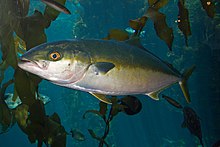
The Zeidae are a family of large, showy, deep-bodied zeiform marine fish—the "true dories". Found in the Atlantic, Indian, and Pacific Oceans, the family contains just six species in two genera. All species are important and highly regarded food fish supporting commercial fisheries, and some—such as the John Dory —are enjoyed in large public aquaria. These fish are caught primarily by deep-sea trawling.

The Atlantic horse mackerel, also known as the European horse mackerel or common scad, is a species of jack mackerel in the family Carangidae, which includes the jacks, pompanos and trevallies. It is found in the eastern Atlantic Ocean off Europe and Africa and into the south-eastern Indian Ocean. It is an important species in commercial fisheries and is listed as a Vulnerable species on The IUCN Red List of Threatened Species.
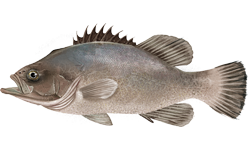
The Atlantic wreckfish, also known as the stone bass or bass groper, is a marine, bathydemersal, and oceanodromous ray-finned fish in the family Polyprionidae. It has a worldwide, if disjunct, distribution in the Atlantic, Pacific and Indian Oceans.
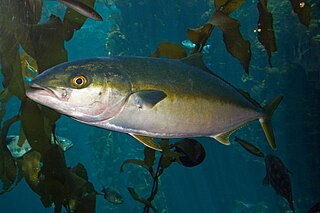
The yellowtail amberjack, yellowtail kingfish, hiramasa or great amberjack is a large fish found in the Southern Ocean. Although previously thought to be found in all oceans and seas, recent genetic analysis restricts S. lalandi proper to the Southern Hemisphere waters. However, they are found in Northern Hemisphere waters during certain times of the year. The fish was given its name by Monsieur de Lalande, a naturalist who first informed zoologist Achille Valenciennes of the existence of this species. His reason for the use of the word Seriola to name the fish is uncertain, but the second word lalandi was derived from his surname. These fish are now being farmed offshore in Maine.
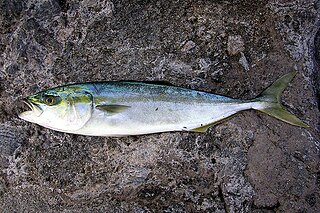
The Japanese amberjack or yellowtail, Seriola quinqueradiata, is a species of jack fish in the family Carangidae, native to the northwest Pacific Ocean. It is known as shiyu (鰤魚) in China, bang'eo (방어) in Korea, and buri or hamachi in Japan.

The blackspot shark is a small species of requiem shark in the family Carcharhinidae found in the tropical Indo-West Pacific Ocean between latitudes 24°N and 30°S, from the surface to a depth around 40 m (130 ft). Its length is a little under one meter (yard) and it is not considered to be dangerous to humans. It feeds mainly on fish, crustaceans, and squid. This shark is also caught in small-scale fisheries for human consumption.

The giant trevally, also known as the lowly trevally, barrier trevally, ronin jack, giant kingfish, or ulua, is a species of large marine fish classified in the jack family, Carangidae. The giant trevally is distributed throughout the tropical waters of the Indo-Pacific region, with a range stretching from South Africa in the west to Hawaii in the east, including Japan in the north and Australia in the south. Two were documented in the eastern tropical Pacific in the 2010s, but whether the species will become established there remains to be seen.

The rainbow runner, also known as the rainbow yellowtail, Spanish jack and Hawaiian salmon, is a common species of pelagic marine fish of the jack family, Carangidae. The species is widespread throughout the tropical and subtropical waters of the world, inhabiting both coastal and offshore areas. The species is the only member of the genus Elagatis, which was created 15 years after its initial description, and is closely related to the amberjacks. The rainbow runner is easily distinguished by its body shape, and the brilliant colouration which gives the fish its name. It is a fast-swimming predator, taking small fish, cephalopods, and a wide variety of planktonic crustaceans. The species reaches sexual maturity around 60 cm (24 in), and spawning takes place at different times, with some populations spawning year round, while others only spawn at certain times of the year. The species is a well known game fish, taken by a variety of fishing methods, and is a well-regarded table fish. Large numbers of the species are taken as bycatch in tuna- and shark-fishing operations and marketed.

The greater amberjack, also known as the allied kingfish, great amberfish, greater yellowtail, jenny lind, Sea donkey, purplish amberjack, reef donkey, rock salmon, sailors choice, yellowtail, and yellow trevally, is a species of predatory ray-finned fish in the family Carangidae, the jacks and pompanos. It is found in temperate, subtropical, and tropical seas around the world. It is a popular quarry species for recreational fisheries and is important in commercial fisheries. It is the largest species in the family Carangidae.

The longfin yellowtail, also known as the almaco or silvercoat jack, deep-water, falcate, European or highfin amberjack, rock salmon, longfin or yellow kingfish, is a game fish of the family Carangidae; they are in the same family as yellowtail and amberjack. They are carnivorous and feed, both day and night, on other, smaller fish, such as baitfish, small squid, octopus, crab and shrimp. The flesh is thick and dense, like tuna, and easily may be passed off for white albacore if prepared as sushi.

Caranx lugubris, the black jack, black trevally, black kingfish, coal fish or black ulua, is a species of large ocean fish in the jack family Carangidae. The species has a circumtropical distribution, found in oceanic, offshore waters of the tropical zones of the Pacific, Atlantic and Indian Oceans. The species is particularly prevalent around offshore islands such as the Caribbean islands in the Atlantic, Hawaii and French Polynesia in the Pacific and the Seychelles and Maldives in the Indian Ocean. Black jack are rare in shallow waters, preferring deep reefs, ledges and seamounts in clear waters. The species is easily distinguished by its black to grey fins and jet black scutes, with the head having a steep profile near the snout. The largest recorded length is 1 m and weight of 17.9 kg. The black jack lives either individually or in small schools, and is known to school with other species. It is a predatory fish, taking a variety of fish, crustaceans and molluscs as prey. Sexual maturity is reached at 34.6 cm in females and 38.2 cm in males, with spawning taking place between February and September in the Caribbean. The early life history of the species is very poorly understood. Black jack are of high importance to many island fisheries, but are rarely encountered in most continental fisheries. The species has a reputation as a gamefish, and is variably considered a terrible or excellent food fish, although several cases of ciguatera poisoning have been attributed to the species. The species was initially named Caranx ascensionis by Georges Cuvier, however several issues with the use of this name have seen Felipe Poey's name Caranx lugubris become the valid scientific name.

The green jack, also known as the horse jack, is an abundant species of coastal marine fish in the jack family Carangidae. The species is distributed in the eastern Pacific Ocean along the American coastline from Santa Cruz Island off California in the north to Peru in the south, as well as a number of islands including the Galapagos and recently, Hawaii. The green jack is distinguished from other similar carangid species by a number of features including gill raker and lateral line scale counts, and the presence of an adipose eyelid. It is a moderately large species, growing to at least 55 cm in length and 2.81 kg, although unconfirmed reports suggest a much larger maximum size. It lives in a wide range of continental shelf environments including estuaries, bays, reefs and offshore seamounts, living both pelagically and demersally. The green jack is a predatory species, preying on a variety of fish, crustaceans and cephalopods, as well as zooplankton. Most fish are sexually mature by the time they attain 38 cm, with spawning occurring between May and October. The species is of high importance to fisheries throughout its range, caught by pelagic trawls, a variety of netting methods and hook and line. The green jack is also of interest to anglers, taken by bait and lures, although is considered to only be fair in eating quality.

Seriola is a genus of ray-finned fish, with many species commonly known as amberjacks. Nine extant species are currently recognized, although these were formerly split into many more. Also, several species are currently placed in several other genera of the Carangidae that were originally described under Seriola. They are a large, carnivorous finfish popularly known for the firm texture and rich flavour of their flesh, which make them an ideal fish for aquaculture. Because specimens caught can weigh up to 100 kg (220 lb), and are powerful swimmers and hunters, they are also highly prized by sport fisherman.

Coastal fish, also called inshore fish or neritic fish, inhabit the sea between the shoreline and the edge of the continental shelf. Since the continental shelf is usually less than 200 metres (660 ft) deep, it follows that pelagic coastal fish are generally epipelagic fish, inhabiting the sunlit epipelagic zone. Coastal fish can be contrasted with oceanic fish or offshore fish, which inhabit the deep seas beyond the continental shelves.
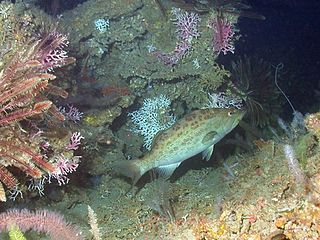
The scamp grouper, also known as scamp, is a species of marine ray-finned fish, a grouper from the subfamily Epinephelinae which is part of the family Serranidae, which also includes the anthias and sea basses. It is found in the western Atlantic Ocean.

Trachurus lathami is a species of fish in the family Carangidae and the genus Trachurus, the jack mackerels. Common names include rough scad and horse mackerel in English, as well as chinchard frappeur (French), chicharro garretón (Spanish), jurel, and carapau, garaçuma, surel, and xixarro. It is native to parts of the western Atlantic Ocean, including seas off the eastern coasts of North and South America and the Gulf of Mexico.

Seriola dorsalis, the California yellowtail is a species of ray-finned fish of the family Carangidae. This species is also known by several alternate names, such as amberjack, forktail, mossback, white salmon and yellowtail tunis or tuna or by its Spanish name jurel. Although previously thought to belong to S. lalandi, recent genetic analysis distinguished California yellowtail as a distinct species from the yellowtail amberjack.

The lesser amberjack, also known as the false amberjack or little amberjack, is a species of ray-finned fish from the family Carangidae, the jacks and pompanos.

The banded rudderfish, also known as the slender amberjack, banded mackerel or shark pilot, is a species of ray-finned fish from the family Carangidae, the jacks and pompanos from the western Atlantic Ocean.

Kyphosus vaigiensis, the brassy chub, brassy drummer, long-finned drummer, low-finned drummer, Northern silver drummer, Queensland drummer, Southern drummer, blue-bronze sea chub, brassy rudderfish, yellow seachub, large-tailed drummer, low-finned chub or long-finned rudderfish, is a species of marine ray-finned fish, a sea chub from the family Kyphosidae. It is a largely herbivorous species which has a circumglobal distribution. Studies in the 21st Century appear to have shown that some other species in the genus Kyphosus are junior synonyms of this taxon.

